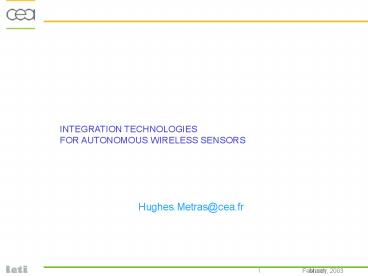Prsentation PowerPoint - PowerPoint PPT Presentation
Title:
Prsentation PowerPoint
Description:
Ultra. low power. low cost. SR radio. Input. devices. sensors ... Ultra. low power. low cost. SR radio. RFID. tag. selected. selected. BPS. Optical Point Me ... – PowerPoint PPT presentation
Number of Views:39
Avg rating:3.0/5.0
Title: Prsentation PowerPoint
1
INTEGRATION TECHNOLOGIES FOR AUTONOMOUS WIRELESS
SENSORS
Hughes.Metras_at_cea.fr
2
Sommaire
- Functional blocks
- Applications
- Enabling technologies
- Energy scavenging, storage and management
- Sensors sensor interfaces
- Data transmissions (standards, RFID, RF, UWB)
- System design and IC design issues
- Conclusions
3
Functional blocks of wireless sensors
- actuation/sensing
- wireless connectivity
- embedded intelligence
- energy management
4
Silicon Technologies Trends
5
Applications mobile terminals
MIMOSA
- MIMOSA vision the mobile terminal serves as a
user interface to ambient intelligence and as a
gateway between local (sensor) information and
global mobile services - The architecture is open for development of
different vertical applications (well-being,
health, home automation, etc.) - 15 partners, 6 countries
- ST Microelectronics
- Nokia
- Legrand
- Suunto
- Sonion
6
Context capturing
FP6 Call 4 Mobile systems beyond 3G
- Provide heterogeneous wireless sensor network
solutions to enable Context Capturing to make
Ambient networks Intelligent, in particular
wireless and mobile systems beyond 3G thus - To enable truly Multi-sensory and Personal mobile
applications and services as well as assisting
mobile communications through sensor information
25 partners Philips, IBM, EADS, Thales,
Telefonica, Fujitsu, Mitsubishi, Coordinator
LETI
7
Applications health/fitness
Sensewear
Suunto
CEA-LETI
- Challenges and future needs
- motion capture, speed,
- integration within textiles, large area low cost
electronics - Physiological parameters monitoring (lactate,
glucose,)
8
Applications transports
- health monitoring (P,T, HUM, VIB)
- Accelerometers
Source EADS
- tire pressure sensors
9
Applications environment security
- Industrial plants
- forest fire detection
- structural health monitoring
- Parasits in homes forests
- Homeland security
10
Energy Scavenging Energy Storage
Energy storage
Micro Fuel cells
Energy scavenging 1,3 mV, 3V, 0,8 Hz
Thickness 10 µm Surfacic capacity 100
µAh/cm² Discharge peak current 500 µA/cm² to 1
mA/cm2
Li Ion batteries
Source MIT Medialab
11
Energy Management
mC
- Monitoring
- Vdd1
- Adaptation
- Up
- Converter
- Command
- Down
- Converter
- Vdd2
DC/DC
- Logic (HW/SW)
- Adaptation to available energy
- Dynamic power supply management
- Wake up and idle mode
12
Sensors
- Humidity
- Pressure sensor
- Accelerometer
- Temp
- Force
- Chemical
- Bio
- Magnetometer
- Gyroscope
13
Sensor Interfaces
Temperature Sensor
Corrections Gain, Bias, T
Capteur
ADC
Signal Conditionning
14
Wireless communications standards
Distance
Graphics
HiFi Audio
Digital Video
Multi-channel Video
Text
Internet
Video streaming
100 km
802.16 WI-Max
GSM/CDMA
GPRS/3G
LMDS
10 km
WAN
1 km
802.11.a/b/g Wi-Fi/HL
100 m
LAN
802.15.4 Zigbee, UWB
10 m
802.15.1 Bluetooth
802.15.3 UWB
PAN
1 m
BAN
10 kbits/s
100 kbits/s
1Mbits/s
10 Mbits/s
100 Mbits/s
Débit
15
Contactless links (RFID)
POWER
- Inductive coupling
- Magnetic field (Near field) at 13,56 MHz
- Antenna Bobine
2 fonctions élémentaires 1- Power Transfer
2- Bi-directional data transfer
DATA
POWER
- Electrical coupling
- Electric field (Far field) at 868 MHz, 2,45 GHz
- Antenna planar or filaire ou planaire
DATA
- Fe 200Hz, SD 14 bits
- Capacitive Pressure Sensor from Tronics
- Miniaturized Antennae
- Challenges
- Performance antenna, reading distance
- complex functions (sensing tags)
16
Wireless link
Figure of merit
c
17
Wireless link narrow band zigbee like
- specifications 802.15.4 Zigbee
- 250kbit/s, 10 m
- ISM band 16 channels in 2400-2480MHz
- Various topologies, tens of nodes
- Challenges
- Power reduction
- RF Mems integration (BAW filters)
- RF functions integration
- Routing protocols
18
Wireless link UWB
Principle very short pulses (lt 1ns)
Low data rate location
- Objectifs
- challenges
- New architectures
- direct sampling
- pulse genrators
- Synchronisation
- Energy detetction
- antenna
19
Integrating system level design IC design
20
Design tuning at system level (v.1)
- Breakthroughs in ULP radios complete
system modeling
fine-tuning of specifications
through system modeling
Impact of receiver imperfections on BER
21
Design tuning at system level (v.2)
- Breakthroughs in ULP radios complete
system modeling
fine-tuning of specifications
through system modeling
Intensive use of high-level languages
(Matlab, System C)
22
Matlab simulation chain
channel and some impairments
transmitter
receiver
23
Matlab simulation chain
- Models for
- Receiver A/D bits
- bit true digital model
- Carrier frequency offsets
- Symbol clock frequency offset
- RF oscillator phase noise (1/f² and white
- Limiter amplifier
- Models for
- Receiver NF
- Receiver gain
- DC offset
- DC offset rejection filter
- IQ imbalance
- Adjacent and alternate channel
- Channel filter
example adjacent channel rejection
- Reference BER formula (non coherent)
- Reference simulation chain
- PER target 1e-2
- PSDU 22 bytes
- BER 5.7e-5
24
Conclusions
- Microtechnologies/Mems may lead to breakthrough
in wireless sensors - Radio architectures
- Sensor interfaces
- Energy scavenging and management
- The convergence of mechanical/thermal/chemical
functions and electrical world of ICs - new design methodologies
- new design tools































